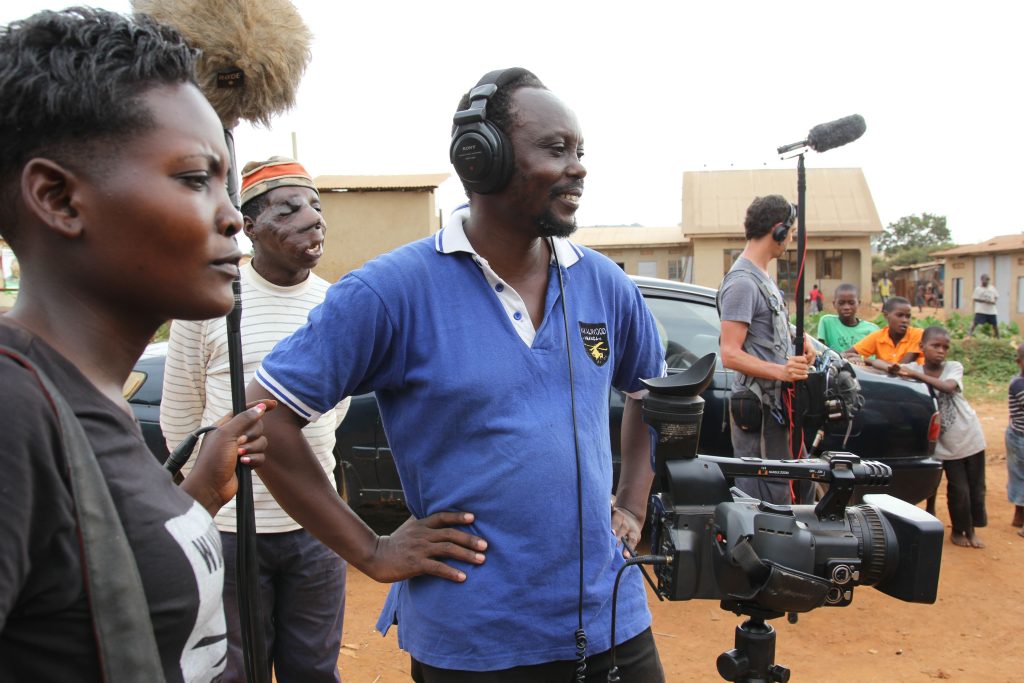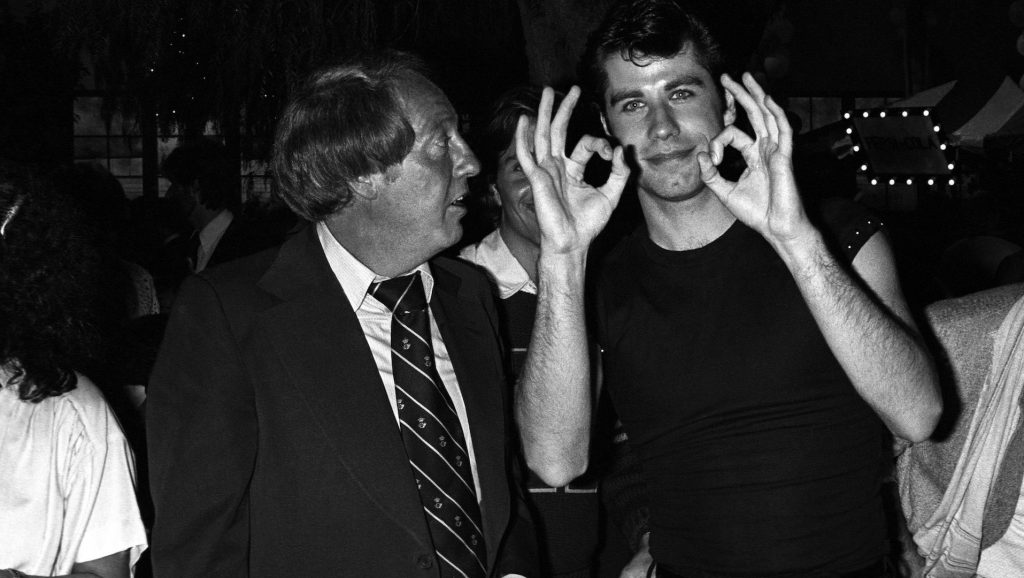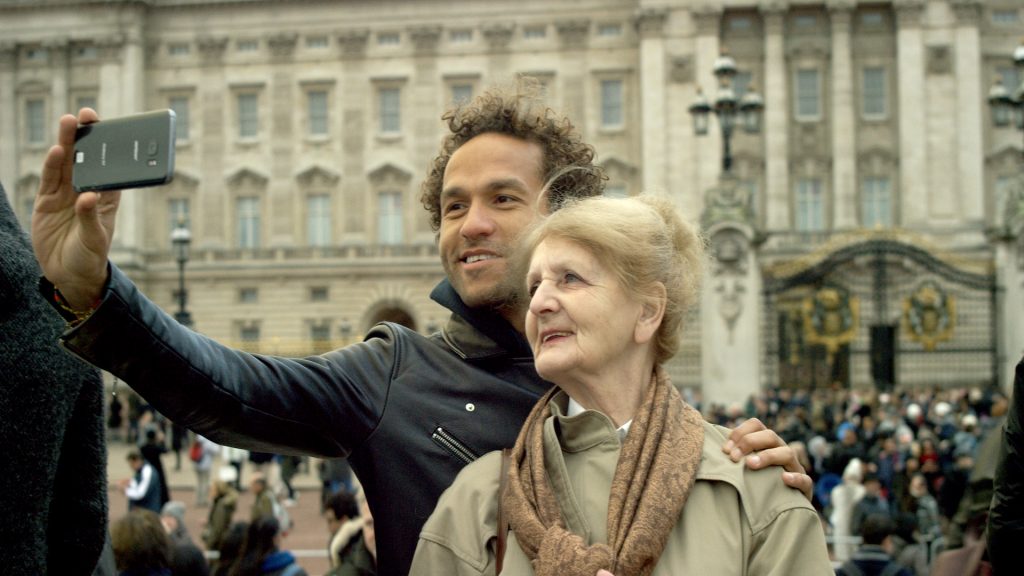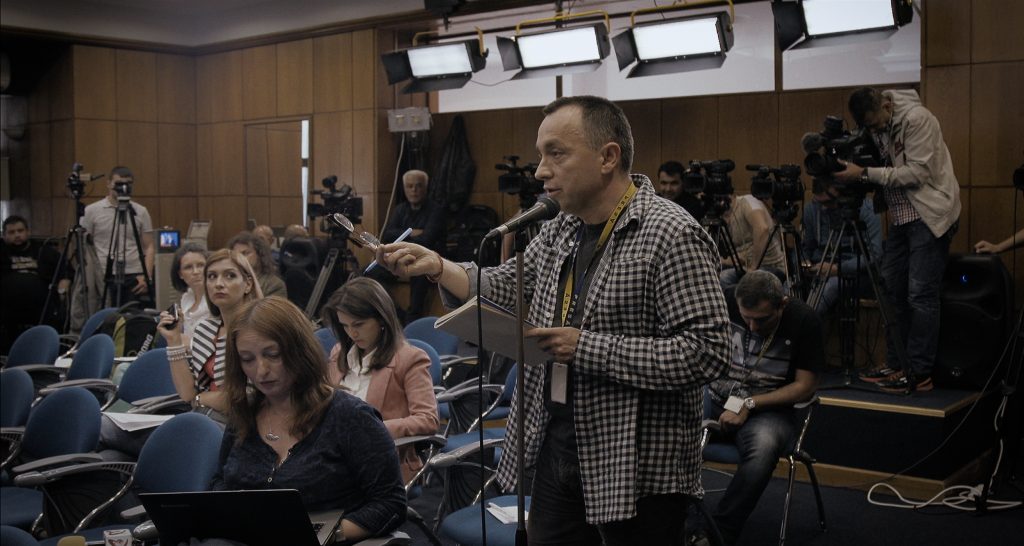November 16, 2021
by Carla Hay

Directed by Cathryne Czubek; co-directed by Hugo Perez
Some language in Swahili with subtitles
Culture Representation: The documentary film “Once Upon a Time in Uganda” features a mostly African group of people (with some white people) in a chronicle of Ugandan indie filmmaker Isaac Nabwana’s ventures with his Ramon Film Productions and the alliance that Nabwana forms with American filmmaker/actor/publicist Alan Hofmanis.
Culture Clash: Nabwana gets volunteer help from Hofmanis, who moved from New York to live with Nabwana and Nabwana’s family in Uganda, but Hofmanis and Nabwana sometimes disagree on Hofmanis’ role and decision making for Ramon Film Productions.
Culture Audience: “Once Upon a Time in Uganda” will appeal primarily to people interested in how independent filmmaking works in Uganda, and how relationships can be affected when friends do business together.

The title of “Once Upon a Time in Uganda” might have been inspired by Quentin Tarantino’s Oscar-winning 2019 film “Once Upon a Time in Hollywood,” because this documentary is ostensibly about Isaac Nabwana, a Ugandan independent filmmaker whose work has been inspired by Tarantino. However, the narrative of the film is from the perspective of Alan Hofmanis, an American filmmaker/actor/publicist. Hofmanis does the voiceover commentary in describing his experiences of getting involved with Nabwana and Ramon Film Productions, the company founded by Nabwana in 2005. It’s a mostly engaging and realistic look at the challenges of independent filmmaking in Uganda, as well as the highs and lows of two friends doing business with each other.
“Once Upon a Time in Uganda” was supposed to have its world premiere at the 2020 SXSW Film Festival, which was cancelled as an in-person event due to the COVID-19 pandemic. Instead, the movie had its U.S. premiere at the 2021 edition of DOC NYC in New York City. [UPDATE: “Once Upon a Time in Uganda” won DOC NYC’s inaugural U.S. Competition Grand Jury Prize.] Directed by Cathryne Czubek and co-directed by Hugo Perez, “Once Upon a Time in Uganda” tells a compelling story, but at times it’s too much of a personal showcase/platform for Hofmanis. More of the spotlight should have been on Nabwana, whose films are the reasons why this documentary exists.
Hofmanis explains in the beginning of the documentary that he first discovered Nabwana when someone showed him a trailer for Nabwana’s movie “Who Killed Captain Alex,” a zany action comedy filmed gonzo-style, which is how you could describe Nabwana’s other movies too. Hofmanis says he was so intrigued with “Who Killed Captain Alex” (a movie that went viral on YouTube), he knew he had to go to the rural town of Wakalisa, Uganda (where Nabwana is based), to meet him in person. However, Hofmanis didn’t know Nabwana’s address or phone number and couldn’t find that information. He went to Wakalisa anyway, with the hope of tracking down Nabwana.
The documentary has a somewhat cheesy scripted segment that’s supposed to be a re-enactment of what Hofmanis experienced when he got to Wakalisa. If you believe this part of the movie, Hofmanis was in an outdoor market where he happened to see a man wearing a Ramon Film Productions T-shirt. He ran after the man and asked him if he knew Nabwana. The answer was “yes,” and that’s how Hofmanis was eventually introduced to Nabwana.
In “Once Upon a Time in Uganda,” Nabwana mentions that he’s 44-year-old married father of three children. He’s a brick layer/brick maker for his day job. But his real passion is filmmaking, especially in the action genre. Nabwana cites his earliest influences as Bruce Lee, Chuck Norris and Sylvester Stallone as Rambo. To hone his filmmaking skills and raise money for his independent films, Nabwana does part-time work filming music videos, TV commercials and wedding videos.
Nabwana began making short films around 2005. He became a one-person creative team, as the writer, director, cinematographer and editor for all of his earliest work. His wife Harriet (who is also in the documentary) says that soon after they got married, he told her that he wanted to be a filmmaker. She’s completely supportive of his goals.
Harriet is also a valuable member of Ramon Film Productions. She handles many production assistant duties on the set, as well as the marketing and packaging of the company’s products. Harriet does all the catering for the cast and crew. (The company doesn’t have the budget to pay cast members, who are all volunteers.) All of this is shown in the documentary.
It’s mentioned several times that Isaac Mabwana and Ramon Film Productions are largely responsible for building a film community in Wakalisa called Wakaliwood. Ramon Film Productions even has its own theme song. Wakalisa is economically deprived, so the Wakaliwood nickname is a source of pride to the people in the community. In the documentary, Hofmanis comments that he likes being involved in African movies that are not about poverty and war. “My argument is that this is a different narrative of Africa,” he says of Ramon Film Productions movies.
But there’s one big problem, which the documentary also shows many times: Ramon Film Productions, although it ends up getting a lot of publicity with Hofmanis’ help, is struggling to make a profit. Isaac describes the audiences for his movies as “peasants. They are the majority.” Not long after Hoffmanis meets Isaac, he offers to help take Ramon Film Productions to the next level of become a world-renowned (and hopefully profitable) independent film studio.
Ramon Film Productions is literally a “mom and pop” business, so what made Hofmanis think he could get involved to the point of moving in with the Nabwana family in Uganda? There’s more to the story of Hofmanis wanting to help as a fan of Isaac’s work. What emerges is a portrait of a well-meaning but somewhat desperate person who ditched his life in New York to try to re-invent himself as a movie wheeler dealer in Uganda. The results were decidedly mixed for Hofmanis.
In the documentary, Hofmanis (who was in his 50s and a bachelor with no children at the time this film was made) describes himself as a movie nerd and a jack of all trades in the film industry. Based for years in New York City, he says that his work experience is being a director, producer, cinematographer and editor of short films, commercials and music videos. Hofmanis also says that he helped program film festivals and has done film publicity. You get the impression that Hofmanis is the cliché of “jack of all trades, master of none.”
If someone does something as extreme such as leaving behind the comforts of a middle-class life in the United States to live in a poverty-stricken area of Africa, it’s usually for personal reasons, not for career advancement. And sure enough, Hofmanis says that when that he decided to sell all of his belongings and gave up his apartment so he could move to Africa, it was around the same time that his fiancée dumped him. He says the day that he bought the wedding ring was the same day that she left him. “It was the perfect storm,” Hofmanis says of the breakup and his decision to move to Uganda.
After this heartbreak and with nothing left to lose, Hofmanis says he decided to pour his energy into helping Isaac. It’s never really explained whose idea it was for Hofmanis to live with the Nabwana family. However, viewers will get the impression (based on what’s said in the documentary) that Hofmanis just showed up to offer his services for free, Isaac accepted the offer, and Isaac let Hofmanis live in his home because he knew that Hofamnis was homeless in Uganda and didn’t know anyone else.
Isaac also seems to be very aware that Hofmanis’ breakup with his ex-fiancée (who’s only identified as Maria) was a big reason for this drastic move: “I don’t know what Maria did to Alan,” Isaac says when he tries to explain why Hofmanis moved to Uganda to do volunteer work for Isaac. The personalities of the two men are quite different from each other: Isaac is laid-back and focused, while Hofmanis is high-energy and neurotic.
Over a period of at least three years that are chronicled in this documentary, Hofmanis lived in a home with no indoor plumbing, unreliable Internet service and electricity that could malfunction at any moment’s notice. It’s mentioned that filmmakers in Uganda often have the problem of computer hard drives that get electrical burn damage because of sudden surges in electricity. Hofmanis spent countless hours promoting Isaac as a filmmaker to anyone who would listen and many people who wouldn’t listen.
Because his diet in Uganda was drastically different from his diet in the U.S., Hofmanis lost weight almost to the point of being emaciated. In the documentary, he occasionally gripes about the discomforts of living in this type of poverty. And there are expected problems in the filmmaking process, such as technical mishaps and running out of money. However, Hofmanis also makes it clear that what he gained—priceless friendships and experiences—far outweighed anything that he considered a “down side.”
The documentary shows how Hofmanis became part of the Ramon Film Productions team, albeit with a role and job title that were never clearly defined. He and Isaac form a genuine friendship, but the vagueness of Hofmanis’ business relationship with Isaac ends up frustrating Hofmanis. It’s hard to feel too sorry for Hofmanis though when he obviously didn’t have the business sense to get a contract about his role in the company.
Hofmanis doesn’t come right out and say it, but it soon becomes very apparent that he was hoping that Isaac would eventually offer him partial ownership of Ramon Film Productions. That offer doesn’t happen. And you can’t really blame Isaac for that decision, because Isaac is the one who founded the company, he created the films, and he got funding for his movies—long before he ever met Hofmanis, who volunteered his services with no contract. If someone professing to be an ardent admirer offered to do all this work for free, most people would not turn down that offer.
Hofmanis is shown being an actor and occasional crew member for the Ramon Film Productions movie “Bad Black,” where he is the only white person in the movie. There’s not much of a plot. He’s shown being hunted by people in combat gear. The action scenes include a lot of martial arts, an area in which Hofmanis admittedly says he is very unskilled, but he learns a little as he goes along. Hofmanis jokes that Isaac’s movies could invent a new “beating up the white guy” genre with Hofmanis as the star.
The documentary shows how Ramon Film Productions has a martial arts training program for children who might want to be in the company’s movies someday. The kids are called Waka Starz. Ramon Film Productions also has video jokers, also known as VJs, who provide running commentary and jokes when the company’s movies are screened to live audiences. (It’s similar to what RiffTrax does in the United States.) The documentary also mentions that most people see Isaac’s movies online or on DVD. The company’s mail-order business includes the sales of DVDs and branded merchandise, but Harriet is seen lamenting that they haven’t been able to turn a profit from these sales.
Through his connections in the media and in the film industry, Hofmanis is able to get major media outlets to give editorial coverage to Ramon Film Productions. CNN, PBS, the Wall Street Journal, Esquire and Vice are among those media outlets. Hofmanis gives the impression that it was his idea to label Isaac as “the Quentin Tarantino of Uganda,” as a hook to get the media interested.
Isaac’s movies are nowhere near as slickly filmed as Tarantino’s movies. Ramon Film Productions movies have comedy that’s juvenile, and the dialogue is bare-bones basic. And due to the very low budgets of Ramon Film Productions movies, the visual effects are cheap-looking and amateurish. However, there’s a love of moviemaking that comes through that is appealing. The comedy is goofy enough to bring some laughs. It’s why Ramon Film Productions has a fan base that Hofmanis thinks deserves to grow on a massive level.
Isaac’s visa/passport issues prevent him from traveling where Hofmanis ends up going to promote Isaac’s work. At various points in the documentary, Hofmanis is seen traveling to Antwerp, Belgium; Seoul, South, Korea; Cannes, France; and Austin, Texas. During these travels, Hofmanis is often present at Ramon Film Productions movie screenings that he arranged to be viewed by the public as limited engagements/specialty screenings at independent cinemas. Over time, Hofmanis begins to think of himself as the spokesperson for Ramon Film Productions.
The documentary shows how Hofmanis met with Toronto International Film Festival (TIFF) programmer Peter Kuplowsky to pitch Isaac’s feature film “Crazy World” as a selection for the festival. “Crazy World” ended up screening as part of TIFF’s Midnight Madness program in 2019. The documentary shows whether or not Isaac was able to work out his passport problems to attend the screening.
“Once Upon a Time in Uganda” is so focused on Hofmanis telling his own story and his own perspective, it might be easy to assume that he’s one of the documentary’s producers, but he’s not. Being a film producer means that you need to have money to pay for a film. “Once Upon a Time in Uganda” makes it abundantly clear that Hofmanis’ lack of money (multiple times in the movie, he says that he’s broke) becomes a point where Isaac and Hofmanis start to diverge.
For all the publicity that Hofmanis was able to generate for Ramon Film Productions, it didn’t lead to any offers from major investors. However, one potential investor began talking to Isaac (this investor is not seen in the documentary), and Isaac didn’t include Hofmanis in the discussions, because Isaac is the sole owner of the business. When Hofmanis finds out he wasn’t included in these discussions, he reacts like a lover who’s been cheated on, and he says he feels betrayed.
Hofmanis and Isaac stop communicating with each other for a while, even though Hofmanis still continues to live in the Nabwana family home. His hurt feelings turn into bitterness. And then, Hofmanis jets back to New York to figure out what to do next because he doesn’t know if he can trust Isaac. When Hofmanis sees his parents again, he acts like Isaac is being the difficult one. It’s at this point in the documentary that Hofmanis and his “woe is me” attitude start to get irritating.
Viewers will probably think Hofmanis has a “white savior” complex, because he thought he could swoop in and show a native Ugandan how to become a financially successful filmmaker. When things didn’t work out the way Hofmanis wanted (he didn’t get the credit and glory he thought he deserved), he began acting like a kid with poor sportsmanship who wants to quit the game and go home just because he’s not the center of attention. Apparently, Hofmanis doesn’t understand that volunteering for a full-time, unpaid job in exchange for a free place to stay does not entitle someone to a partnership or equal decision making in the company.
Early on in the documentary, Isaac brings up the issues of race and social class, when he says that in the film industry, “the white man is king” and “the corporate class is skeptical” that Isaac can make a movie because Isaac is “poor.” And so, it’s very likely that even though Isaac and Hofmanis became friends, Isaac was probably using Hofmanis for white privilege, just like Hofamnis was probably using Isaac to feel like a white savior. It’s important to remember that Hofmanis volunteered to do all of this work for Isaac without being paid. Therefore, Isaac shouldn’t be made to look like a disloyal villain for accepting the help and wanting to retain sole ownership of his company.
And really, what did Hofmanis expect? For all of his lofty plans, nothing that Hofmanis did in this documentary helped Ramon Film Productions become profitable. At one point, Harriet started a cake-making business because the family was losing money on the film production company. At no point in the documentary is Hofmanis shown working at any “regular” job in Uganda to help raise money for the company, or even to help the family with household expenses. Maybe he thought that getting a “regular” job in Uganda would be too “beneath” him, since he wanted to be perceived as a hotshot American filmmaker.
That’s not to say that Hofmanis didn’t genuinely want to help, but an objective observer can see that he was somewhat using this relocation to Uganda to escape from a life that was making him unhappy in New York. No one was forcing him to live in poverty and volunteer his services to a struggling film company in Uganda. It was all of his own free will. You also have to question the “business savvy” of an admittedly financially broke person who does all of this full-time business work without a contract.
It would be wrong to assume that “Once Upon a Time in Uganda” is only about gonzo filmmaking in Uganda. The documentary is also a lesson in what can happen when friends work together without a contract and with the naïve assumption that no one will ever get greedy or selfish in making business decisions. If Hofmanis had an ulterior motive to be made a partner in Ramon Film Productions (and it sure looks like that was his ulterior motive), Isaac made the right decision to not give up any stakes in the company to someone who came along as a volunteer. And in that respect, Isaac Nabwana has a lot more business intelligence than maybe some people think he has.
UPDATE: Yellow Veil Pictures and Drafthouse Films will release “Once Upon a Time in Uganda” in select U.S. cinemas on July 4, 2023. The movie will be released on digital and VOD on July 25, 2023.






























